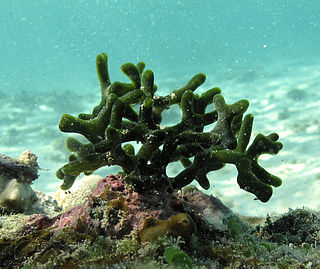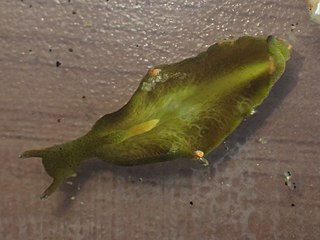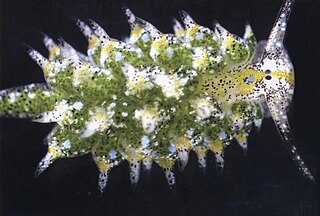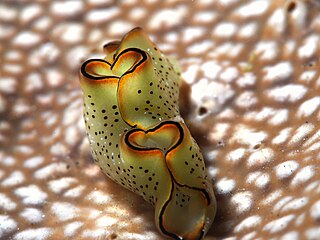
Sacoglossa, commonly known as the sacoglossans or the "solar-powered sea slugs", are a superorder of small sea slugs and sea snails, marine gastropod mollusks that belong to the clade Heterobranchia. Sacoglossans live by ingesting the cellular contents of algae, hence they are sometimes called "sap-sucking sea slugs".

Fucus is a genus of brown algae found in the intertidal zones of rocky seashores almost throughout the world.

Kleptoplasty or kleptoplastidy is a process in symbiotic relationships whereby plastids, notably chloroplasts from algae, are sequestered by the host. The word is derived from Kleptes (κλέπτης) which is Greek for thief. The alga is eaten normally and partially digested, leaving the plastid intact. The plastids are maintained within the host, temporarily continuing photosynthesis and benefiting the host.

Codium is a genus of edible green macroalgae under the order Bryopsidales. The genus name is derived from a Greek word that pertains to the soft texture of its thallus. One of the foremost experts on Codium taxonomy was Paul Claude Silva at the University of California, Berkeley. P.C. Silva was able to describe 36 species for the genus and in honor of his work on Codium, the species C. silvae was named after the late professor.

Elysia chlorotica is a small-to-medium-sized species of green sea slug, a marine opisthobranch gastropod mollusc. This sea slug superficially resembles a nudibranch, yet it does not belong to that clade. Instead it is a member of the clade Sacoglossa, the sap-sucking sea slugs. Some members of this group use chloroplasts from the algae they eat for photosynthesis, a phenomenon known as kleptoplasty. Elysia chlorotica is one species of such "solar-powered sea slugs". It lives in a subcellular endosymbiotic relationship with chloroplasts of the marine heterokont alga Vaucheria litorea.

Elysia viridis, the sap-sucking slug, is a small-to-medium-sized species of green sea slug, a marine opisthobranch gastropod mollusc in the family Plakobranchidae.

Elysia is a genus of sea slugs, marine gastropod molluscs in the family Plakobranchidae. These animals are colorful sea slugs, and they can superficially resemble nudibranchs, but are not very closely related to them. Instead they are sacoglossans, commonly known as sap-sucking slugs.

Elysia crispata, common name the lettuce sea slug or lettuce slug, is a large and colorful species of sea slug, a marine gastropod mollusk.

Elysia timida is a species of sacoglossan sea slug, a marine opisthobranch gastropod mollusk. Found in the Mediterranean and nearby parts of the Atlantic, it is herbivorous, feeding on various algae in shallow water.

Elysia pusilla is a species of small sea slug, a marine gastropod mollusk in the family Plakobranchidae. It is a sacoglossan.

Elysia maoria is a species of marine gastropod mollusk in the family Plankobranchidae. It is found off of New Zealand.

Plakobranchus ocellatus is a species of sea slug, a sacoglossan, a marine opisthobranch gastropod mollusk in the family Plakobranchidae. It is found in shallow water in the Indo-Pacific region.

Vaucheria litorea is a species of yellow-green algae (Xanthophyceae). It grows in a filamentous fashion. V. litorea is a common intertidal species of coastal brackish waters and salt marshes of the Northern Atlantic, along the coasts of Europe, North America and New Zealand. It is also found in the Eastern Pacific coasts of Washington state. It is found to be able to tolerate a large range of salinities, making it euryhaline.

Codium fragile, known commonly as green sea fingers, dead man's fingers, felty fingers, forked felt-alga, stag seaweed, sponge seaweed, green sponge, green fleece, sea staghorn, and oyster thief, is a species of seaweed in the family Codiaceae. It originates in the Pacific Ocean near Japan and has become an invasive species on the coasts of the Northern Atlantic Ocean.

Elysia australis is a species of sea slug, a marine gastropod mollusc in the family Plakobranchidae. This sea slug resembles a nudibranch, but it is not closely related to that order of gastropods, instead it is a sacoglossan. It occurs in Australia.

Elysia trisinuata is a species of sea slug, a marine gastropod mollusc in the family Plakobranchidae. This sea slug resembles a nudibranch but is not closely related to that order of gastropods, instead belonging to another clade, Sacoglossa, the "sap-sucking" sea slugs.

Acetabularia acetabulum is a species of green alga in the family Polyphysaceae. It is found in the Mediterranean Sea at a depth of one to two metres.

Costasiella ocellifera is a small (5–13 mm) species of sea slug, a shell-less marine gastropod mollusk in the family Costasiellidae. Costasiella ocellifera, and other members of the Costasiellidae family are often mistakenly classified as nudibranchs because they superficially resemble other species of that group, but they are actually a part of the Sacoglossa superorder of sea slugs, also known as the “sap-sucking sea slugs,” "crawling leaves" or the "solar-powered sea slugs." C. ocellifera was discovered by Simroth in 1895, and was initially classified as Doto ocellifera. The Brazilian species, Costasiella liliana, is a synonym of C. ocellifera.Costasiella ocellifera shows long-term retention of functional kleptoplasty.

Elysia marginata is a marine gastropod in the family Plakobranchidae. It is known for its ability to regenerate its whole body and heart after autotomizing it from its head.

Elysia atroviridis is a benthic species of sea slug belonging to the family Plakobranchidae native to the northwest pacific. E. atroviridis slugs live up to three meters deep, and are generally dark green in skin colour with small, black spots all around the body. E. atroviridis is a member of the superorder Sacoglossa, and thus possesses the ability to perform kleptoplasty. E. atroviridis and Elysia marginata are notable for possessing the ability to completely autotomize their bodies and grow them back within 20 days.




















